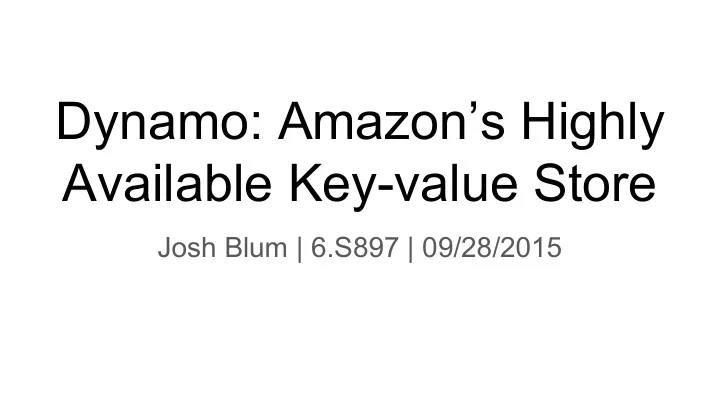

Dynamo: Amazon’s Highly Available Key-value Store Josh Blum | 6.S897 | 09/28/2015
Introduction - Amazon’s e-commerce platform serves tens of millions customers at peak times using tens of thousands of servers located in many data centers around the world. - Need for a scalable and highly available key-value store - Choose to focus on an eventually consistent store - Sacrifices consistency for availability
System Assumptions and Requirements - Query Model Data is uniquely identified by a key, stored as binary blob - - No need for relational schema - Efficiency - Runs on commodity heterogenous hardware infrastructure - Stringent latency requirements: SLA is 300ms for 99.9th percentile requests - Other Assumptions - Security isn’t an issue
API - get(key) - Returns a single object or a list of objects with conflicting versions along with a context - Conflicts are handled on reads, never reject a write - put(key, context, object) - context refers to various kinds of system metadata
Data Partitioning - Consistent hashing - Output range of a hash is treated as a ‘ring’. - Assign a key to each object (MD5 of 128-bit client supplied key) - MD5(key) -> node (position on the Ring) - Incrementally scalable: adding a single node does not affect the system significantly - “Virtual Nodes” - Each node can be responsible for more than one virtual node. - Work distribution proportional to the capabilities of the individual node
Data Partitioning
Replication Example: N=3 - Node B replicates the key k at nodes C and D in addition to storing it locally. - Node D will store the keys in the ranges (A, B], (B, C], and (C, D].
Data Versioning - System is eventually consistent, thus a get() call may return stale data - An object can have distinct version sub-histories, the system needs reconcile in the future - Uses vector clocks in order to capture causality between different versions of the same object.
Vector Clocks - A vector clock is a list of (node, counter) pairs. - Every version of every object is associated with one vector clock. - When a client wishes to update an object, it must specify which version it is updating. - This is done by passing the “context” it obtained from an earlier read operation, which contains the vector clock information.
Sloppy Quorum - R : minimum number of nodes that must participate in a successful read operation - W : the minimum number of nodes that must participate in a successful write operation - Setting R + W > N yields a quorum-like system. - The latency of a get() (or put() ) operation is dictated by the slowest of the R (or W ) replicas - R and W are usually configured to be less than N , to provide better latency.
Sloppy Quorum: get() - get() : coordinator reads from N nodes; waits for R responses. - If they agree, return value. - If they disagree, but are causally related, return the most recent value - If they are causally unrelated apply reconciliation techniques and write back the corrected version
Sloppy Quorum: put() - put() : the coordinator writes to the first N healthy nodes on the preference list. - Coordinator writes new version vector clock locally and forwards to N highest ranked reachable nodes - If W-1 more writes succeed, the write is considered to be successful
(N, R, W) Configurations - Typical: (3, 2, 2) - Balances performance, durability, and availability - W = 1 - Never reject a write as long as one node is alive - Low values of W and R can increase the risk of inconsistency - Requests are successful before being processed by a majority of the replicas. - Introduces vulnerability window for durability for writes
Failures - Like Google, Amazon has a number of data centers, each with many commodity machines. - Individual machines fail regularly - Sometimes entire data centers fail due to power outages, network partitions, tornados, etc. - To handle failure of entire centers, replicas are spread across multiple data centers. - Hinted handoff for transient failures - Merkle trees for replica synchronization
Questions?
Recommend
More recommend